Whether you’re on a city break, a stopover, or setting out on a longer adventure, find out what to do in Oman’s capital with our 3-Day Muscat itinerary.
Muscat, the sweeping, mountain-backed capital of Oman, is the unassuming gateway to one of the most beautiful and diverse countries in the Middle East.
Wedged along a 50-kilometre strip of coast between the sparkling Gulf of Oman and the stark brown rises of the Al Hajar mountain range, Muscat is a striking blend of ancient and modern, with a low-key vibe and an authenticity all its own.
In this post, we explore some of the top things to do in Muscat, with a suggested 3-Day Muscat itinerary that takes in the historic old city, the bustling port town of Mutrah, the beautiful Sultan Qaboos Grand Mosque, and sunset aboard a traditional dhow boat.
Understated though it might be, Muscat is a great place to ‘meet’ Oman, and get a feel for the country’s past, its culture and its people, whether you’re touching down for a brief visit, or setting out on a longer Oman adventure.

What’s in this post?
Planning a Trip to Muscat
– How long do I need to visit Muscat?
– Getting to Muscat
– Getting around Muscat
– Muscat car rental
– Where to stay in Muscat
3 Days in Muscat Itinerary
– Day 1: Explore historic Old Muscat
– Day 2: Wander through buzzing Mutrah
– Day 3: Visit Sultan Qaboos Grand Mosque and enjoy a sunset dhow cruise
– Things to do in Muscat with more time
This post contains affiliate links. If you choose to buy through these links we may earn a small commission at no extra cost to you, which helps us to keep Two for the World running. Many thanks for your support!
Planning a Trip to Muscat
We’ve outlined answers to a few of the most common planning questions below, however if you want a more comprehensive summary of things to know before you visit Muscat, check out our planning a trip to Oman post.
How long do I need to visit Muscat?
There are plenty of things to do in Muscat to keep you busy for two or three days.
This amount of time will allow you to comfortably explore the main highlights, including the stunning Sultan Qaboos Grand Mosque, the Royal Opera House, the lively Muttrah Souq and Corniche, along with the sites of Old Muscat.
With more time, you could venture outside the city to places like the Daymaniyat Islands for snorkelling or Scuba diving, head inland for a taste of Oman’s rugged mountain and desert landscapes, or find time to explore some of the country’s famous wadis.
If you’re tight on time, you can certainly see plenty of Muscat in a day, but to make the most of your visit, we’d recommend giving it a couple of days.
Getting to Muscat
Muscat International Airport (which used to be called Seeb International Airport) is located around 30km from the Old City. Most hotels will happily arrange a transfer for you, or you can book ahead with a reputable provider like Welcome Pickups.
It’s also a fairly straightforward journey to get to Muscat overland from Dubai in the neighbouring United Arab Emirates, but this will take the better part of a day.
Getting around Muscat
Muscat edges the Gulf of Oman for some 50km. With limited public transport the easiest way to get around is to hire a car, hire a car and driver, or flag cabs for rides around the city.
If you’re keen on doing day trips from Muscat, you can arrange for a car and driver in most hotels, and taxi drivers will also offer private trips and tours just about anywhere.
Muscat car rental
Having a rental car in Muscat is a convenient option for getting around the main sights of the city, particularly given the wide geographical area Muscat covers.
With decent, if fairly busy roads, Muscat is a fairly car-friendly city, with plenty of available parking, including complimentary parking at many hotels.
We’ve always found the best deals at DiscoverCars and they’re our go-to car hire provider these days, with great rates and free cancellation should your plans need to change.
We’d recommend booking your Muscat car rental in advance to get the best rates and widest choice of vehicle.
Where to stay in Muscat
Muscat is a long, spread-out city wedged between the Al Hajar mountains and the Gulf of Oman. It’s not a high-rise capital – more more a series of low-key neighbourhoods connected by wide roads and coastal views.
When it comes to choosing where to stay, it’s all about what kind of trip you’re after. There are plenty of options to suit all budgets and tastes, with most providing complimentary parking for guests.
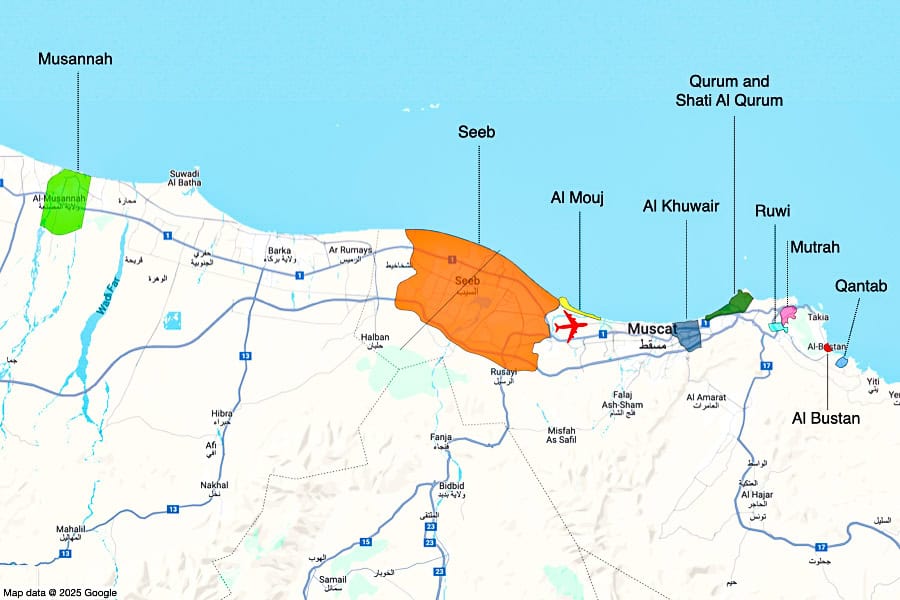
Mutrah
Mutrah is a popular area to stay due to its location on the coast and proximity to Old Muscat. It has a lovely Corniche along the coast, a lively traditional souq, bustling fish market, and a modest range of accommodation options.
We opted to stay at the well-priced Mutrah Hotel, with simple, clean rooms and friendly staff. It’s conveniently located between Mutrah and Ruwi, just over 2km from Mutrah Corniche. Other options in Mutrah that get consistently good reviews include:
- Good value: Riyam Hotel – spacious rooms | 20-min walk to Mutrah Corniche | swimming pool
- Mid-range: Fort Guesthouse – modern with traditional touches | great location | near Mutrah Corniche.
Ruwi
Just inland from Mutrah, the commercial neighbourhood of Ruwi may not be the prettiest, but it’s well located and has some good-value budget and mid-range hotels. The following options all get decent reviews:
- Good value: Haffa House Hotel – spacious, clean rooms | friendly staff | rooftop pool
- Mid-range: Golden Tulip Headington – neat and tidy rooms | pool and gym | nice location near shopping and restaurants
- Spend a bit more: Sheraton Oman Hotel – large, clean rooms with comfy beds | multiple restaurants | pool and spa facilities | exceptional staff.
Al Bustan and Qantab
Al Bustan and nearby Qantab are quiet coastal areas east of central Muscat, set between dramatic cliffs and the sea.
Al Bustan is best known for the luxury Al Bustan Palace, a Ritz-Carlton hotel offering high-end facilities in a stunning, secluded setting backed by the Al Hajar Mountains on a sweeping private beach.
Qantab is more low-key, with a small beach and a handful of guesthouses and simple accommodation, ideal for travellers seeking a peaceful stay away from the city.
We did some fabulous SCUBA diving from here and It’s also extremely popular for snorkelling.
Qurum and Shati Al Qurum
On the coast west of Mutrah, you’ll find the suburbs of Qurum and Shati Al Qurum. These popular beach neighbourhoods offer mostly mid-range and up-market stays with good shopping and dining options close to the city’s main attractions. Solid options here include:
- Good-value: Arabian Nights Nook – clean, spacious rooms | large, shared kitchen | friendly hosts | nice quiet area | close to beach
- Spend a bit more: Crowne Plaza Muscat – clifftop location with panoramic views | well-appointed rooms | choice of restaurants and bars on-site | private beach | shuttle to main city sights
- Spend a bit more: W Muscat – waterfront location | tasteful, comfy rooms | two swimming pools | helpful staff | on-site restaurants and bars.
Al Khuwair
Further west of Qurum towards the airport, bustling Al Khuwair is a mixed commercial and residential area a few kilometres east of Sultan Qaboos Grand Mosque. The area is home to numerous shops, restaurants and cafes, making it a lively area for visitors to stay, with accommodation tending towards the budget and mid-range brackets. Options receiving consistently good reviews include:
- Good-value: Golden Tulip Muscat – comfy, spacious rooms | close to shops and restaurants | nice rooftop pool with bar/restaurant and sea views
- Good-value: Hilton Garden Inn Muscat Al Khuwair – clean spacious rooms | friendly staff | rooftop pool and gym | central location
- Mid-range: IntercityHotel Muscat – modern rooms | pool and gym | short walk to beach | tasty breakfast | good location attached to shopping mall.
Al Mouj
If you’re looking for something a bit fancy, head to the Al Mouj area where you’ll find a few big-name resorts with private beaches and all the trimmings, conveniently located close to the airport. Top stays here include:
- Mid-range: Mysk Al Mouj Hotel – lovely modern hotel | large rooms with comfy beds | rooftop pool with views | great location near marina and beach
- Spend a bit more: Kempinski Hotel Muscat – really comfortable rooms | beachfront location | various resort facilities | uber-modern
- Spend a bit more: The St Regis Al Mouj Muscat Resort – stylish 5 star beachfront hotel | large spacious, modern rooms | courteous, professional staff | 2 large pools | gym and spa facilities
Seeb
For a slightly less glitzy but more local vibe, head further west to Seeb, a large coastal district close to the international airport. It’s a mostly residential area with local markets, shopping centres and access to quieter beaches. There’s a range of budget and mid-range stays around here, with the following getting decent reviews:
- Good value: Al Hail Waves Hotel – close to beach | swimming pool | ocean view rooms available
- Mid-range: Maani Muscat Hotel & Suites – modern rooms with large beds | apartments also available | lovely, helpful staff | large outdoor pool
Musannah
Musannah is a quiet, more relaxed coastal town with a nice marina around 90 minutes west of central Muscat, often considered part of the wider Muscat region for travellers heading along the coast. Accommodation is limited but includes the large beachfront Barceló Mussanah Resort.
We had a lovely room here for a couple of nights at the end of our Oman road trip. The area has a nice, relaxed vibe and there’s a pleasant, family friendly beach scene, so if you want some beach or pool time this might be a good bet.
3 Days in Muscat Itinerary
We’ve organised our 3 day Muscat itinerary so the main sights of the city can be visited independently at a fairly leisurely pace, with time for meal breaks and avoiding being outside at the hottest time of day.
While Muscat’s sights are fairly spread out across the city, it’s pretty easy to cover the highlights using taxis or your own hire car.
However, if you have less time, or would prefer to have a more in-depth introduction to Oman’s capital city, there’s a range of popular tour options available.
We often opt for guided tours when we want to gain a deeper understanding of the history and culture of a place. They’re also a great way to meet other travellers, and get useful insights and tips from a local guide.
The following guided tours get consistently decent reviews and have secure booking and free cancellation:
- Muscat City Highlights Tour: This half-day guided group tour with optional hotel pickup covers Muscat’s main cultural highlights, including the Sultan Qaboos Grand Mosque, Royal Opera House, Muttrah Souk and Al Alam Palace. Private tours are also available for an additional fee.
- Muscat Half-Day City Tour with Audio Guiding: Offering a snapshot of Muscat, this half-day group tour combines key landmarks like the Sultan Qaboos Grand Mosque, Al Alam Palace and Bait Al Zubair Museum with a wander through Muttrah Souq and fish market. Audio commentary is provided in five languages and hotel pickup is included.
- Muscat Full-Day City Tour: This full-day exploration of Muscat covers the main cultural and historic landmarks, including the Sultan Qaboos Grand Mosque, the Royal Opera House, Mutrah Souk, Al Alam Palace, and the National Museum. Group and private tour options are available.
Day 1: Explore historic Old Muscat
Highlights: Muscat Gate Museum | Bait Al Zubair Museum | Al Alam Palace | Al Mirani Fort | Al Jalali Fort | Mutrah Corniche
Old Muscat is the city’s historic heartland: the original Muscat. Fortified by mountains, sea and 400-year-old walls and watchtowers, Old Muscat’s low-rise white buildings offset the jagged, mustard-coloured hills surrounding it.
Start your Muscat sightseeing at the Muscat Gate Museum. Since today’s plan involves walking back to Mutrah this afternoon, we’d suggest grabbing a cab to the museum to save your legs for later.
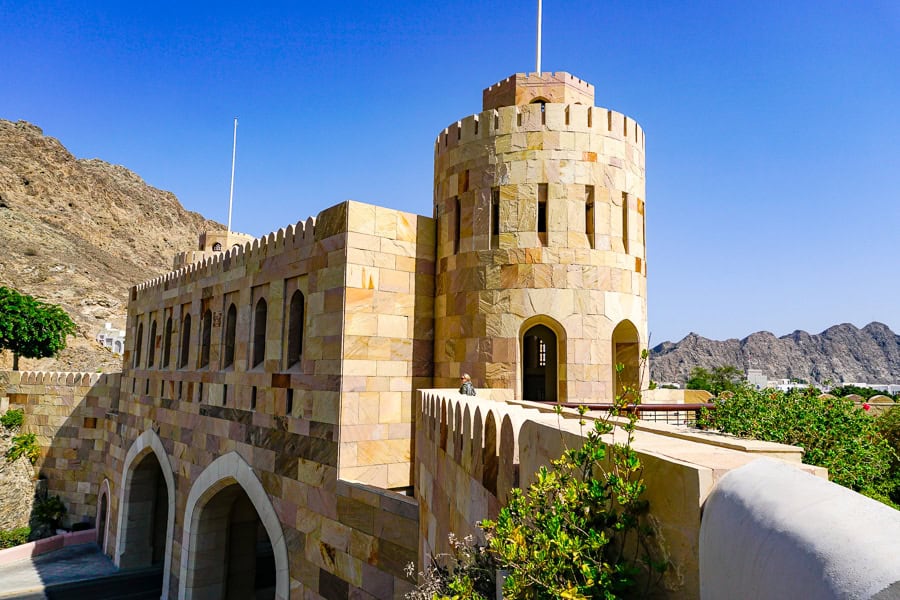
Muscat Gate Museum is a tiny gallery exploring Oman’s history. As Muscat tourist attractions go, this one won’t rock your world, although there are some interesting exhibits on the country’s clever systems for managing water in a parched environment.
But the unusual building straddling Al Bahri Road marks the original, 17th-century city gateway and walls, so it’s a fitting spot to start our tour of Old Muscat.
From the museum, wander down to Bait Al Zubair Museum. This oasis is among the best things to do in Muscat: a beautiful traditional Omani home, restored and reopened as a private collection of Omani culture and artefacts, from weaponry to furnishings and costumes.
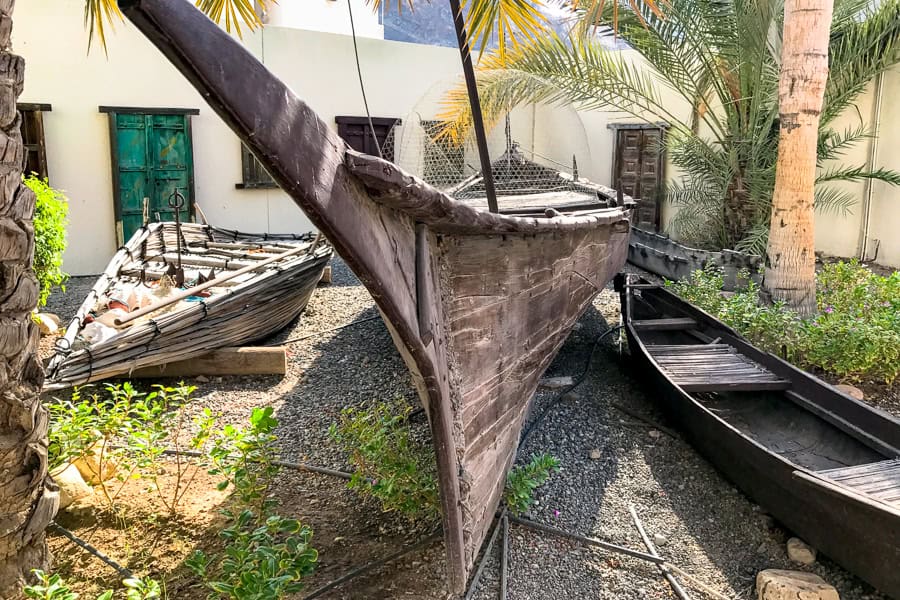
There’s also a contemporary art gallery and a café on site. It’s easy to while away the time here. When we finally sat down to a steaming cup of Omani coffee and dates, we realised we’d lingered much longer than anticipated.
Top Tip: Look out for the wind tower in the café space, a traditional means of cooling homes in this scorching landscape.
If you’re road tripping Oman, you’ll notice these rectangular wind towers on top of homes right around the country.
As a result, we decided to leave our next planned stop, the National Museum, for another visit. Depending on how you’re travelling though, this sweeping, modern gallery is by all accounts an excellent and engaging introduction to Oman’s long and epic history and culture.
Alternatively, you could check out the nearby Omani-French Museum, a niche option that explores the historical relationship between Oman and France.
A 10-minute stroll from Bait Al Zubair brings you to the gates of Al Alam, the ceremonial palace of Oman’s king, Sultan Qaboos.
While the Sultan’s palace isn’t open to the public, you can take pics of the elegant blue and gold facade from the front gate. If you have time, head back here at night to see the palace lit up.
To the left of the front gate, a side street goes to the harbour, passing between the palace and the 16th-century Portuguese Al Mirani Fort, which has been open to the public since April 2024 following restoration work.

Make your way down here and spend some time taking in the columned palace from this angle, as well as Al Jalali Fort across the water. Sadly Al Jalali is closed to the public, although we’ve read that with some planning, you can apply for a permit to visit.

As the afternoon rolls on, it’s time to start making the slow walk back to Mutrah, along the famous Mutrah Corniche.
More and more locals will start emerging as the temps cool, making the Corniche a lively place to wander in the late afternoon and early evening.
En route, you’ll come to Kalbuh Park, a pretty waterside spot that’s popular with young families and couples. We hung out here until the lights of the Corniche came on and the sky over the mountains behind Muscat turned orange.
You can continue your Corniche amble all the way back to Mutrah as we did, or flag a cab for the final leg.
There are lots of options for dinner in Mutrah. We were keen for some authentic Omani fare, so we made our way to popular Bait Al Luban.
There, we feasted on barbecued skewers called Mishkaks, a flavour-filled firepit-cooked meat dish called Shuwa, and a delicious Omani chicken curry called Saloonat Dijaj.

Day 2: Wander through buzzing Mutrah
Highlights: Mutrah Fish Market | Mutrah Souq | Mutrah Fort | Ghalya Museum of Modern Art | Reyani Park and Riyam Park Monument
For your second day in Muscat, go local and explore the traditional trading hub of Mutrah.
The busy town is famous for its market, as well as twilight wanders along the Corniche. But there are also a handful of other attractions worth checking out among the traditional merchant homes.
Start your day at the Mutrah Fish Market, at the western end of the Corniche. If you’re early enough, you’ll find Muscat’s fisherman offloading the day’s catch from their colourful dhows.

Inside the fish market building, locals haggle over rows of ice-packed stainless steel trays piled high with fresh seafood, as wiley cats watch on hopefully.
This modern market is still relatively new (it opened in 2017) and we’re told all the gleaming chrome doesn’t have quite the same character as the old market did, but it’s still interesting to watch the action.
Just down the road, the vendors of Mutrah Souq are rolling up their shutters for the morning market.
We visited the souq both in the morning and in the evening, and found it to be much livelier at night, so we’d recommend leaving the labyrinthine passageways until tonight.
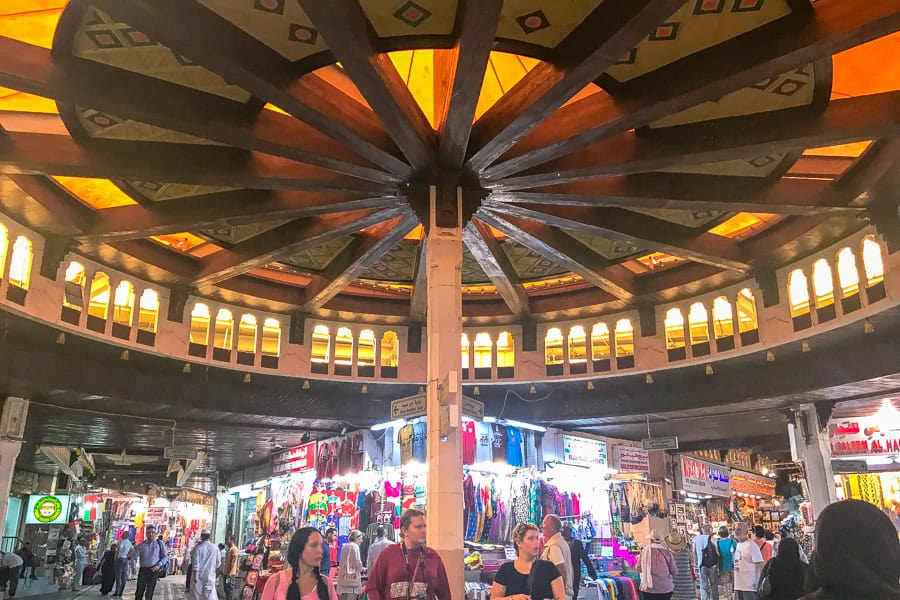
Take the opportunity though, to have a gander at the glittering treasures of the Gold Souq while it’s still relatively quiet, before continuing on along the Corniche and past the imposing 16th-century Mutrah Fort, another site that is now open to the public after extensive renovations. It’s worth a visit for the views over the harbour.
Just past the fort, you’ll come across the Ghalya Museum of Modern Art. This charming and quirky little traditional home weaves a maze through the rooms and memorabilia of one family’s personal story. The wander winds up in a small gallery of contemporary artworks.
By now the heat will have well and truly settled in, so take the opportunity to lunch indoors or head to one of Mutrah’s museums, like the impressive Sultan’s Armed Forces Museum or the folksy Bait Al Baranda.
Once the temps start to cool, it’s time to get back out on the Corniche and wander down to Reyani Park with the locals.
Climb up the Riyam Park Monument, affectionately known as the ‘incense burner’, for sunset views over Mutrah, the mountains and the seafront.
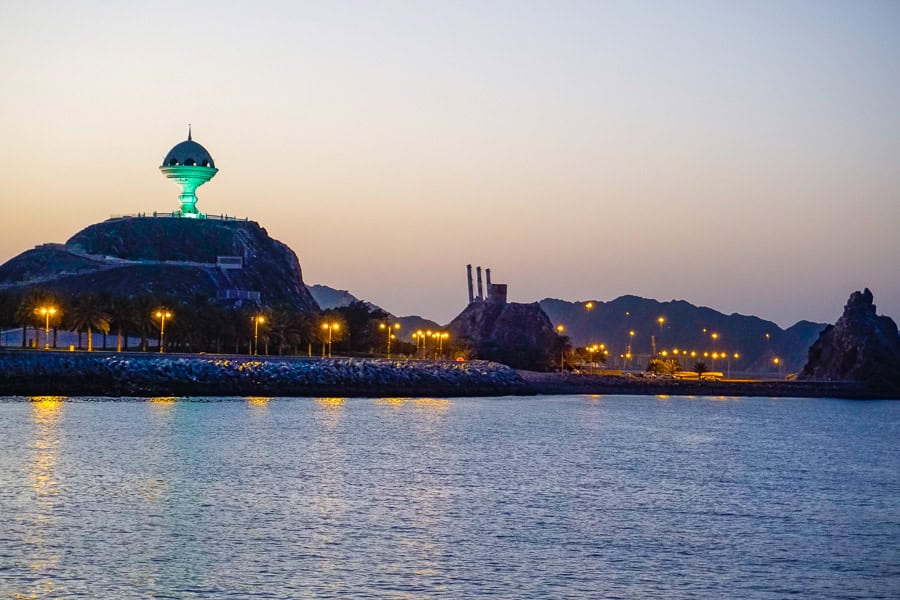
Grab dinner at one of the open-air restaurants on Mutrah Corniche tonight. We opted for simple but tasty plates of shwarma and glasses of spicy lime juice.
Juice Nation: While a cold beer might feel like just the ticket at the end of a hot day exploring Muscat, you won’t find booze on the menus: it’s against the law to drink or be drunk in public in Oman (check your country’s travel advice for more detail on this).
The silver lining is that, in addition to amazing Omani coffee and delicious tea, fresh fruit juices are king here.
Our absolute favourite bevvie in Muscat was a fresh lime juice spiced with blended jalapeños. We stopped to sip it and people watch pretty much every day at one of the fast food and juice joints next to Mutrah Souq.
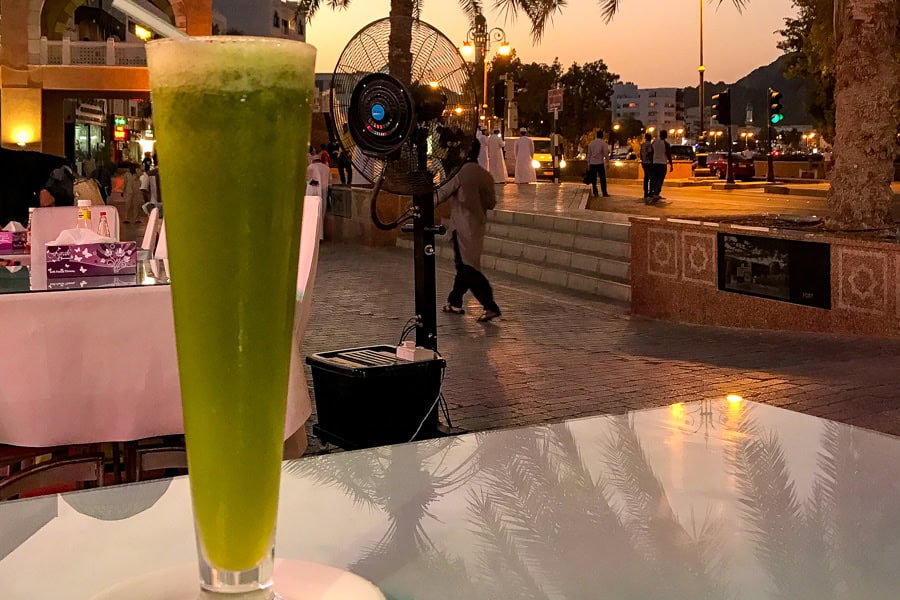
Day 3: Visit Sultan Qaboos Grand Mosque and enjoy a sunset dhow cruise
Highlights: Sultan Qaboos Grand Mosque | Natural History Museum | sunset dhow cruise
An absolute must-see on any Muscat itinerary is the Sultan Qaboos Grand Mosque.
Located around 25-kilometres to the west of Mutrah, this is Oman’s principal mosque: a vast and exquisitely decorated sandstone building set within lush gardens and surrounded by tiled arcades.

Commissioned by Sultan Qaboos in the 1990s, the mosque’s various spaces can hold up to 20,000 worshippers at a time (you’ll notice hundreds and hundreds of shelves in the arcades all over the grounds, where shoes are deposited before entering the mosque).
Sultan Qaboos Grand Mosque is an active house of worship, so it’s only open for visitors between 8am and 11am each morning, and it’s closed on Fridays.
Take a cab from Mutrah to the mosque in time for opening, and aim to spend a couple of hours here.
Culture Spotting: As you travel to Sultan Qaboos Grand Mosque from Mutrah or Old Muscat, keep an eye out for the beautiful Islamic-Italianate-style Royal Opera House on your right.
The Opera House has a calendar of events year-round, so if you have an evening free while you’re visiting Muscat, maybe check out what’s on.
The highlight of Sultan Qaboos Grand Mosque is hands down the ornate interior of the main musalla (prayer hall), and its delicately tiled mihrab (a wall niche indicating the direction of Mecca).
The magnificent Persian carpet here was once the world’s largest. Likewise, the 8.5-tonne crystal chandelier suspended from the beautiful dome above.
Both titles now sit with the Shaikh Zayed Grand Mosque in Abu Dhabi; a fact that takes nothing away from these extraordinary handcrafted creations.
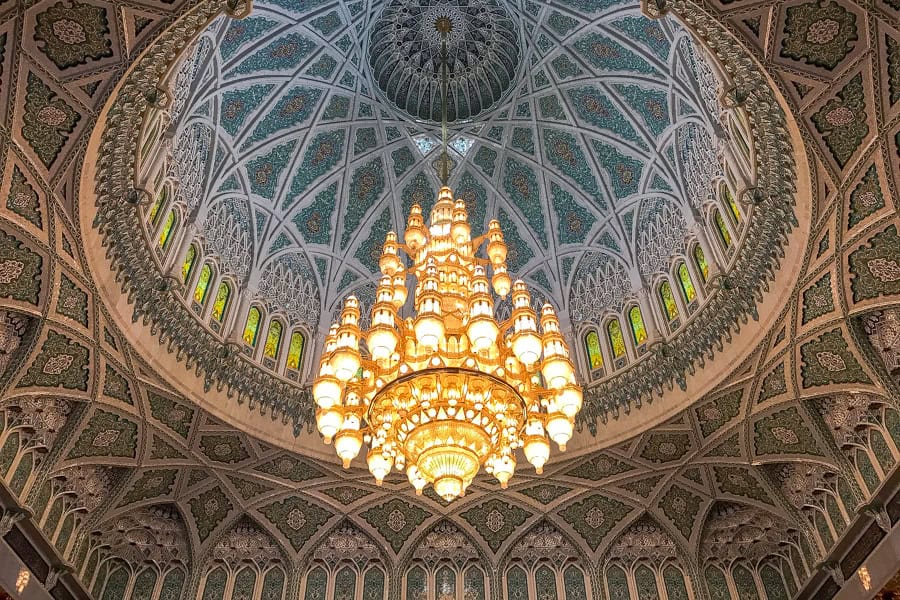
Back outside, take the opportunity to wander the beautiful courtyards of the mosque.
The arcades surrounding the main building are decorated with tiled niches showcasing the evolution and diversity of zellij – mosaic tilework – from across the Middle East (there are small plaques in English explaining the origins and history of the tilework in each arcade).
Dressing for the mosque: Oman is a conservative country and while tourists are given a bit of leeway when it comes to what we wear, it’s respectful to take a cue from the locals and dress appropriately.
For women, this means not wearing tight or revealing clothing generally, but especially when it comes to visiting mosques.
Wear loose, airy clothing (it’s better in the heat anyway), and bring a scarf, as you will also be required to cover your hair. Guys should cover their knees and shoulders. Everyone must remove their shoes before entering the mosque.
We’ve written in more detail about what to wear in our post on planning a trip to Oman.
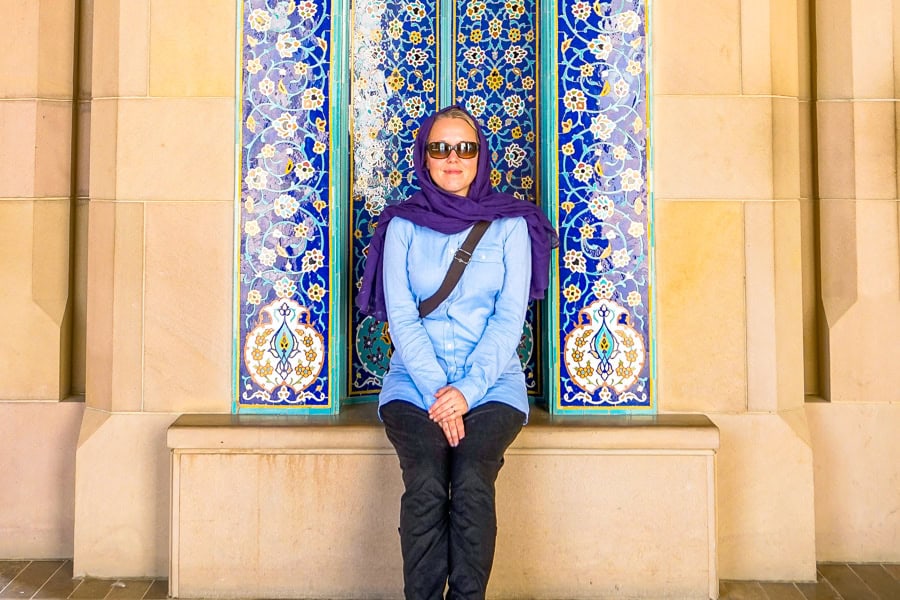
With the sun approaching its zenith, it’s time to head indoors for a couple of hours. If you’d like to stay local, the Natural History Museum is a short cab ride away. Or maybe find a good spot for lunch.
We had already organised through our hotel to join a sunset dhow cruise in the late afternoon on Day 3, including transfers from our hotel. So we made our way back to Mutrah to chill out until the sun started to drop.
If you want to organise your dhow cruise in advance, you can book this 2 hour dhow cruise through GetYourGuide. It’s an excursion that gets decent reviews from other travellers and has secure booking and free cancellation.
History spotting: If your sunset dhow cruise departs from Marina Bandar Al Rowdha, south-east of Old Muscat, you may pass the historic dhow boat – the Sohar – en route.
The Sohar is a replica of a dhow that was built and sailed 6,000 nautical miles from Oman to China, by a sailor named Abdullah Bin Gasm, more than 1,200 years ago!
This version, which is permanently dry-docked in the middle of the Al Bustan Palace roundabout, was commissioned for a reenactment of the epic sea voyage in 1980.
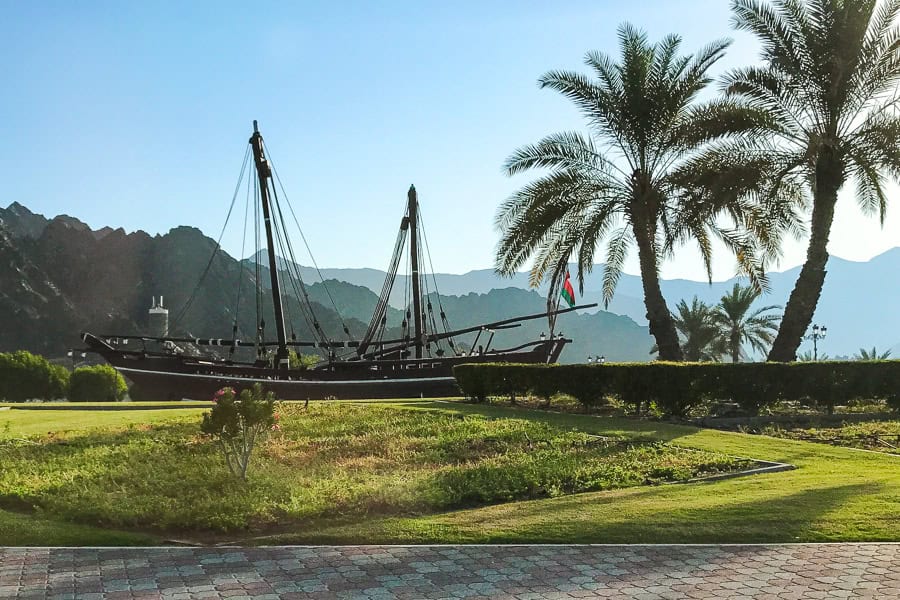
It was still scorching hot when our beautiful dhow boat set off in the late afternoon from Marina Banda Al Rowdha, to cruise along the coastline along Old Muscat and Mutrah.
But with the sun dropping behind the Al Hajar mountains, and the sky turning molten gold, we reckon this is the perfect way to wind up an awesome 3-day Muscat itinerary.
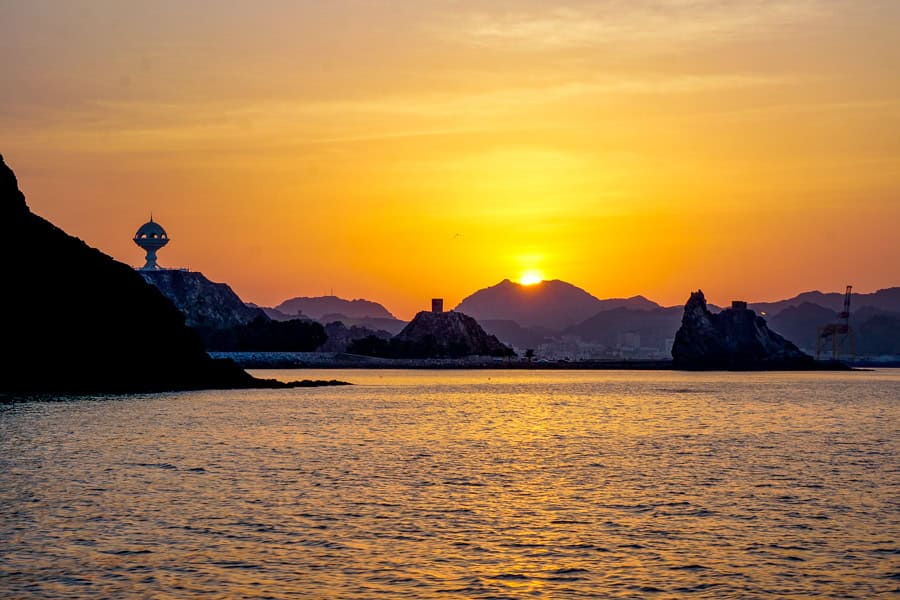
Finish up your Muscat sightseeing tonight with a final Omani meal. We returned to Bait Al Luban as we enjoyed the food so much, but for alternatives, check out this post over at Migrationology on recommended eats in Muscat for food lovers.
Things to do in Muscat with more time
With more time, options for things to do in Muscat and the surrounding area explode into a whole world of possibilities.
If you’re planning a longer trip to Oman, you might be interested in our 2-week self-drive Oman itinerary for suggestions on where to visit and what to do with a fortnight in this amazing country.
But even with two or three extra days in Muscat, there’s a range of experiences worth considering.
Visit the Daymaniyat Islands
With an extra day or two in Muscat, you could get back out on the water to enjoy a snorkelling trip to the World Heritage Daymaniyat Islands.
This protected group of nine islands just off the coast of Muscat are home to turtles, reef sharks, and colourful fish with clear, calm waters ideal for all experience levels.
The extremely popular Daymaniyat Islands Snorkeling Trip departing from Seeb Port lasts around 4-5 hours and gets rave reviews from other travellers. The tour includes multiple snorkelling stops, and all your gear, snacks and drinks on the day. Between November and April, visitors can also go ashore.
Dolphin watching in Muscat
The waters around Muscat are home to several species of dolphin, including spinner and bottlenose, and a dolphin watching trip is one of the most popular things to do in Muscat.
These tours typically last around two to three hours and leave from the marina in the morning, when the sea is calm and the chances of spotting dolphins are highest.
This popular 3-hour Dolphin Watch & Snorkel Excursion combines the chance to see dolphins with a relaxed snorkelling stop. The tour includes snorkelling gear, light refreshments, and optional hotel transfers within Muscat.
SCUBA diving near muscat
Oman is home to a handful of outstanding dive locations, including the Daymaniyat Islands, and the reefs and wrecks of Bandar Kharyan just south of Old Muscat.
We spent a day beneath the waves with Extra Divers Qantab and it turned out to be one of our Oman highlights, and something we’d certainly recommend if you have the time.You can read all about our experience here.
Wadi Shab & Bimmah Sinkhole
Oman is famous for its many wadis and swimming spots, and none are more deserving of that fame than Wadi Shab and Bimmah Sinkhole, two of our favourite swimming spots in Oman.
You can visit these sites independently, but a full-day group tour is an easy way to do both in a day. You’ll be taken on a scenic drive through the rugged Omani landscape before arriving at Wadi Shab, where a short boat ride and a 40-minute canyon hike leads to a series of natural pools and a ‘hidden’ waterfall inside a cave.
After lunch at a local restaurant, the tour heads back towards Muscat, stopping at Bimmah Sinkhole on the way. This deep limestone crater is filled with surprisingly cool, clear water and it’s the perfect spot to cool down while cave fish nibble at your feet.
This full-day Wadi Shab & Bimmah Sinkhole tour includes transport, lunch and bottled water, and is ideally suited to people with a moderate level of fitness that are comfortable with hiking and swimming.
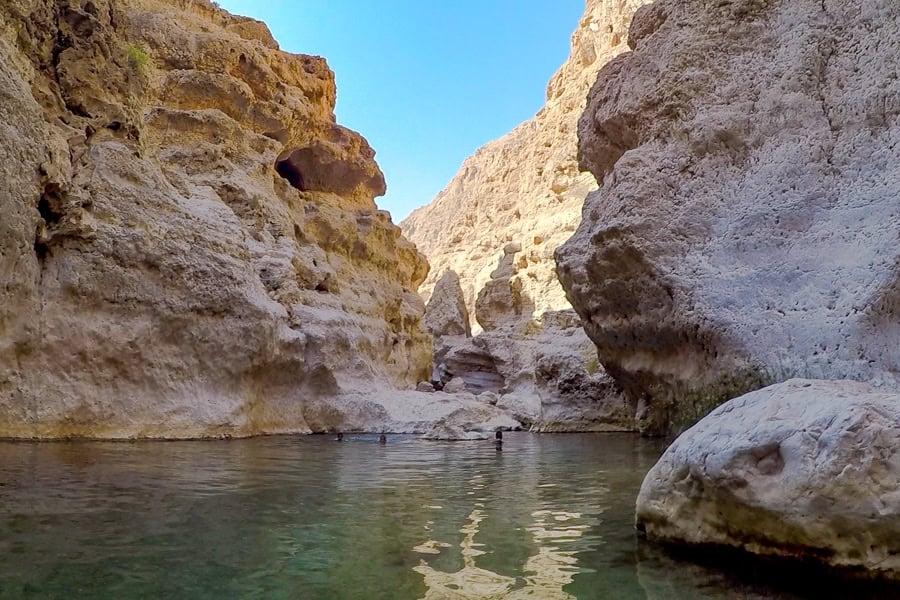
Visit Nizwa and Jebel Akhdar
While we absolutely loved spending a few days in Nizwa and the mountains during our own Oman road trip, it’s certainly possible to get a taste of both on a day trip from Muscat.
This Nizwa and Jebel Akhdar small group tour from Muscat offers a mix of culture and scenery, including time at Nizwa’s imposing fort and a visit to the nearby souq. After lunch in Nizwa, the tour continues to Jebel Akhdar, known for its terraced farms, cool climate, and spectacular mountain scenery.
The trip gets extremely good reviews from other travellers, and includes hotel pickup, a guide and lunch. There’s also an option to extend the tour with an overnight stay in the mountains for an additional fee.
Get into the spectacular Omani desert
Our final pick for must-do excursions with more time in Muscat would be a visit to the Wahiba Desert. In fact, we’d go as far as saying no trip to Oman would be complete without a desert visit, if you can spare the time.
We’ve been lucky enough to spend a few days in and around the deserts of Oman, but you can get a sense of the country’s impressive desert landscape on the Wahiba Desert and Wadi Bani Khalid Guided Group Tour.
The tour begins with a visit to Wadi Bani Khalid, where you can enjoy a swim in striking natural pools surrounded by palm trees and rocky cliffs, before heading to a local restaurant for lunch. In the afternoon you’ll get to enjoy a 4WD tour through the golden dunes of Wahiba Sands, where you can really appreciate the vastness and beauty of Oman’s desert scenery.
Again, this is another small group tour (max 12 people) that gets great reviews and includes hotel pickup, a guide and lunch. There are also options to extend the tour to include sunset in the desert, or even stay overnight in a desert camp, another experience we’d highly recommend.

We hope you found our Muscat itinerary helpful! If you want to know more about visiting this beautiful corner of the Middle East, head over to our Oman page for all of our Oman travel blog posts.
And if you’ve got any questions or comments about this post, we’d love to hear from you, just pop your thoughts in the comments box below!
If you’re looking for more great adventures, check out our Itineraries page, and our bucket bucket list of 100 ultimate road trips around the world.

I’m looking forward to visit Muscat soon , one of the smost beautiful cities in the Middle East, I’m told !
Hi han mu kang, it most definitely is a beautiful place to visit – we hope you have a wonderful time! Thanks for checking out our post!